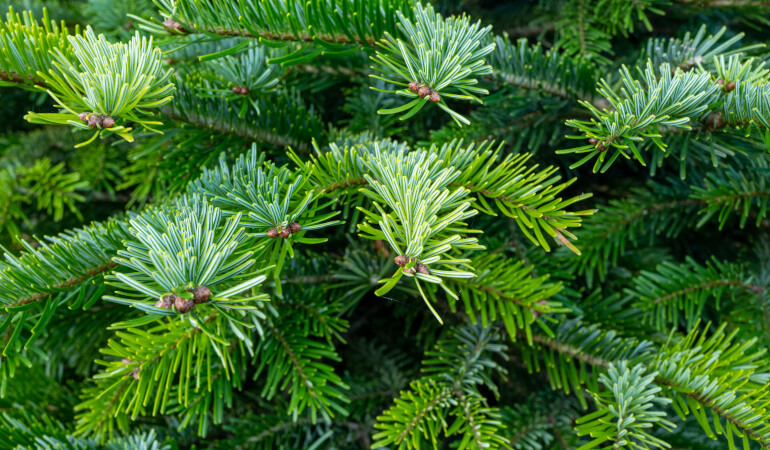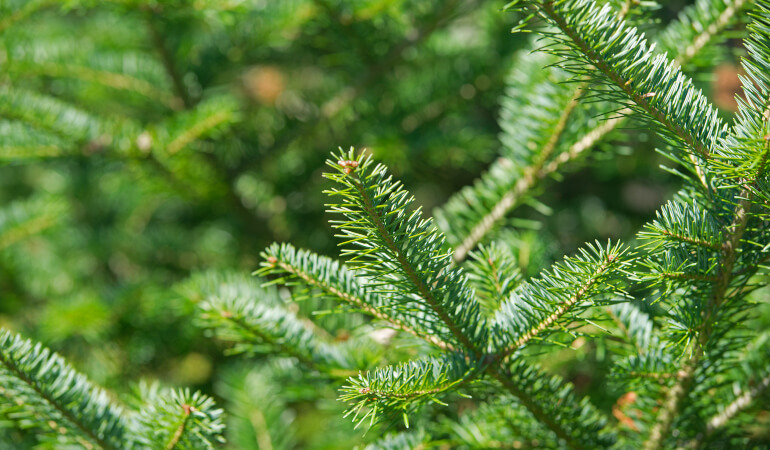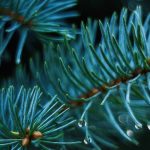
The crisp breeze in the air and pumpkin-spiced everything can only mean one thing: the jolly season is upon us.
With Christmas fast approaching, there’s more to do than wrap presents and make travel arrangements. The festivities won’t be complete without the perfect centrepiece. Selecting the perfect tree, however, may not be as easy as you think. They come in all sorts of shapes and sizes.
Some fit in spacious homes, whereas others are more convenient for modest flats. Many types also drop needles, while others are easier to maintain. To minimise the hassle during this season of merriment, this carefully curated guide will help you identify which Christmas tree doesn’t shed.
Table of Contents
Why do Christmas trees lose needles?
There’s nothing quite like the fresh, earthy smell of a real pine tree to put you in the Christmas spirit. A thinning tree has the opposite effect. It will zap the fun right out of the room, leaving a trail of spiky needles behind.
How much shedding is normal, and why do Christmas trees lose their needles in the first place? The culprit is ethylene, a naturally occurring hormone triggered by the surrounding environment of the plant, along with a variety of other factors.
In the wild, it helps fruit ripen and flowers bloom, but it seems to induce shedding once the tree is placed indoors. You see, dry, humid environments aggravate the shedding process exponentially, and so does insufficient watering.
Pine trees generally thrive in their natural environment, so the risk of severe water loss is not really that prominent. When taken out of their habitat, though, they will shed their needles as a protective measure to stave off serious damage once they begin to dry out too much. It’s essentially a defence mechanism.
Genetics play a role here as well. Some kinds of Conifer species are more predisposed to shedding. Noble or Fraser Firs, for example, are better at retaining moisture and keeping their needles than Norway Spruces. However, some trees still do better than others within the same species, which goes to show that genetic factors do indeed affect needle retention.
The time they were cut also matters. Branches that were trimmed early in the fall tend to shed more than others that have had enough time to acclimate to the cold weather.
Some researchers even found that the lights you use to adorn your tree also affect its longevity. Full-spectrum LED lights can potentially delay the needle shedding by up to 35 days.
Which Christmas trees have the best needle retention?
That being said, the type of tree remains the biggest determining factor of all. Firs usually perform best in that regard, while spruces will cover your floor in a spiky carpet before you even have time to open your presents. Pines strike a balance between both. They still shed, but only a little.
There’s no type of Christmas tree that doesn’t shed needles at all, but there are some that are less bothersome than others.
1. Nordmann Fir

There’s a reason why Nordmann Firs are the first on this list. As some of the most sought-after trees in the UK, these luscious varieties are a sight to behold.
Their symmetrical silhouette starts at a wide base and gradually thins out towards the top. Draped in glossy, dark green, and broad needles all throughout, these are perfect for hanging lightweight ornaments.
So, you’ll be able to decorate them to your heart’s desire, without worrying too much about cleaning up around them. Their leaves are rather soft too, which makes them great for households with curious pets and young kids.
Nordmanns are widely regarded as the best non-drop Christmas trees. They retain their needles for much longer than other traditional varieties. Plus, they are easy to acquire. If you check with your local Christmas tree delivery service, these will surely be on top of their best-sellers list.
2. Fraser Fir

Known for their delightful pine scent, the aromatic fragrance of a Fraser Fir tree will make you feel like you’re living out your nomadic dreams right there in your living room.
Moreover, their relatively narrow base makes them ideal for small spaces. Their sturdy branches and rich, blue-green colour are similar to those of the traditional Norway Spruce varieties, but they don’t drop nearly as many needles.
They do, however, withstand the weight of heavy ornaments, so you don’t have to go through the dilemma of choosing which trinkets will make it this year.
With a Fraser Fir, all your baubles will get a chance to shine. Their most distinguishable feature, besides their permeating smell, of course, is perhaps their dense, silver-tinged underside. It’s basically like they come with their own tinsels!
3. Noble Fir

Another strong contender among the select few pine trees that shed the least, Noble Firs have an impressive needle retention rate.
They are native to the US, which makes them harder to find in the UK or other parts of the world. By extension, this makes them more expensive. If you manage to get your hands on one, your Christmas party will be the talk of the town, thanks to their unique, luxurious appearance.
Their whimsical, green-grey waxy needles curve upwards and rest on thick, sturdy branches that are perfect for heavier decorations. With the right care, they can hold their distinctive needles for up to a month, filling your home with a refreshing, citrusy fragrance long after the festivities are over.
These are also pet- and child-friendly, as their foliage is rounded at the ends, eliminating any concerns about accidental stabs and pricks.
4. Balsam Fir

If you’ve ever seen a fake miniature tree, it was probably modelled after a Balsam Fir.
Renowned for their conical shape and fragrant, long-lasting needles, it’s no wonder these incredible trees have become the epitome for Christmas across the globe.
Their lavish, dark green needles are also speckled with natural hints of silver, adding a little bit more sparkle to your decorations. Additionally, their alluring, vibrant hues and small, round pines make them a spectacular addition to wreaths, garlands, and festive bouquets.
Though they’re on the smaller side as far as non-drop Christmas trees go, what they lack in size, they make up for in tantalising fragrance. Their permeating complex aroma is fresh and bright, yet woody and earthy at the same time.
How to keep a Christmas tree from shedding
Essentially, if you buy a cut tree rather than a potted one, you have a plant with a shorter lifespan. So, it’s natural for some needles to drop. Nonetheless, there are several preventative measures to prolong the life of any Christmas tree and avert the shedding for as long as possible.
1. Choose a fresh tree
The first rule of thumb when shopping around is to pick the freshest tree you can find. There are a few things you should look for to know which Christmas tree sheds the least, starting with the colour. The needles should be green, not brown, and the base where it was sawn should be pale. This tells you that the tree has been recently harvested and will last a good amount of time since it hasn’t been off its roots for that long.
Another good way to test the freshness of a non-drop Christmas tree is to run your fingers along a branch. The needles shouldn’t fall off easily if the tree is healthy and well-maintained. A couple of stray needles are no cause for concern, but if they start to fall like snow, then this is definitely not the tree you want.
Weight and smell are also solid indicators that verify a tree’s freshness. A heavy, fragrant tree still has sap running through it, whereas a light one that has lost its characteristic pine scent is already dying.
2. Prepare it for the indoor environment
Before bringing your tree inside, you need to prepare it for its new home to give it a fighting chance. Take off the net wrapping and make a cut a few centimetres off the bottom of the trunk with a pruning saw.
Some Christmas tree delivery services take care of this for you. In that case, roughly scoring the bark at the base would be enough. This will remove the resin that could have started to form and help it absorb water more efficiently. Place it in a bucket of water in a cool, shady spot outside afterwards to replenish the lost moisture.
If yours is a potted tree, make sure the soil it comes with is nutritious and of high quality. You also need to check the container size to verify whether it is big enough. Repot it into a larger container with a good mix of sand and compost, if needed, to extend its lifespan. This also minimises its fallen needle count and helps fortify the trunk and branches, making it less likely to tilt or topple over under the weight of your ornaments.
Finally, give it a good shake to dislodge any loose needles. Now, your tree is ready for decoration.
3. Place it away from the heat
Non-drop Christmas trees don’t thrive in artificial heat, whether it’s from a fireplace, a radiator, or even a south-facing window. Your decorative lights can also cause your tree to shed and turn brown quickly.
Ideally, you should place it away from these heat sources and use only a few small LED lights that don’t radiate much heat to keep it from drying out prematurely.
You also need to keep an eye on the humidity level in the room. If the air feels too dry, consider turning on a humidifier to prevent dehydration.
4. Give it plenty of water
Watering your pine tree regularly won’t just slow down needle loss. It will also make it look fuller.
Investing in a stand with a water reservoir is highly advisable for pre-cut trees to provide them with a constant supply of fresh water. Preferably, it should have a water level indicator as well so you would know when to top it up.
Check the tree reservoir at least once or twice a day and make sure it doesn’t drop below the bottom of the truck. Most varieties of Christmas trees need around a litre of water for every inch of trunk diameter per day.
For potted trees, you’ll want the soil to be damp, but not wet. Be careful not to over-water it. Otherwise, this will cause the roots to decay, which in turn, tinges the needles with an unsightly yellow and brown shade and accelerates their fall.
Order a real Christmas tree online and leave the setting up to us!
Enter your postcode to view our rates and availability in your area.
For questions about the services we offer visit our main site
Takeaways
- Nordmann, Fraser, Noble, and Balsam Fir are the most common species of pine trees that shed the least.
- Carefully choosing a fresh, evergreen tree is key for minimising needle loss.
- The longevity and needle drop rate of a Christmas tree usually depend on how well you look after it.



